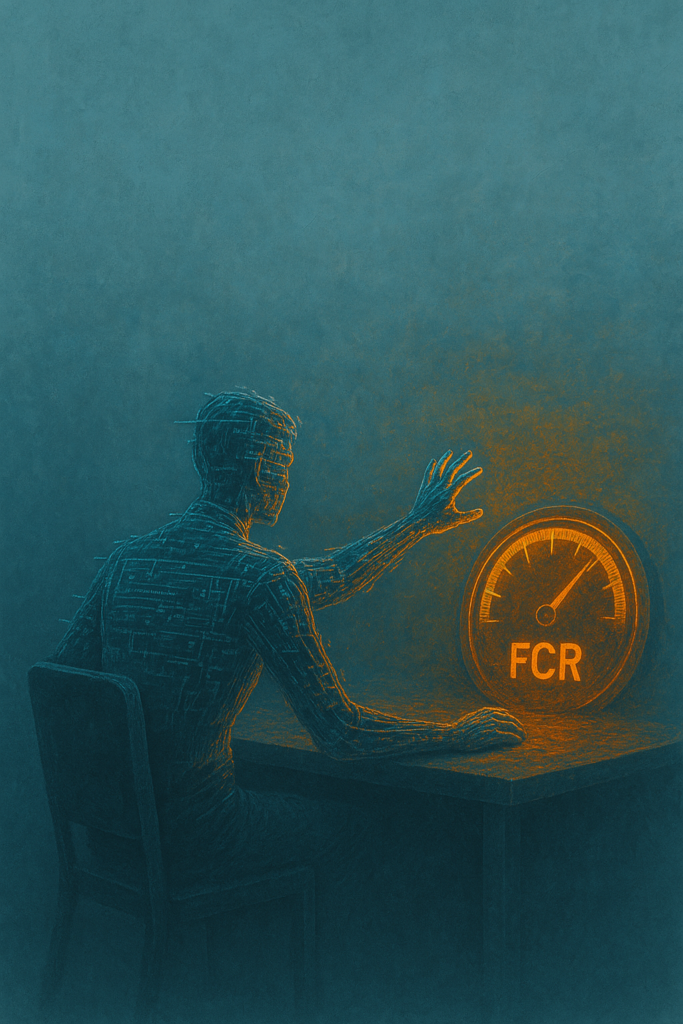If you could keep just one contact center metric—burn the dashboards, cancel the KPIs—First Contact Resolution (FCR) is the hill to die on.
It’s the closest thing we have to a universal truth in customer service: Fix it the first time.
Do that consistently and you reduce costs, boost satisfaction, and stop annoying people. Simple, right?
The Superfood of the Contact Center
Think of vitamin aisle: NPS, CSAT, AHT, ASA… shelves full of supplements. But FCR? That’s your protein shake and green smoothie in one. It improves both effectiveness and efficiency.
If your FCR is high, you’re probably running a tight ship. If it’s low, you’re leaking time, money, and goodwill with every contact.
What Are We Even Measuring?
At its core, FCR asks one question: Did we actually solve the customer’s issue the first time they reached out?
Sounds easy. But as soon as you try to measure it, you’re in a philosophical fistfight.
Calculating FCR: Welcome to Chaos
The classic formula: Total number of inquiries resolved the first time / Total number of inquiries
But the numerator—“resolved”—is where everything goes sideways. How do we define it?
3 Common (Flawed) Methods:
- Survey-based: Ask the customer, “Was your issue resolved?” → Biased, subjective, often low response rates.
- Repeat interactions within X days: → Arbitrary time window. Did they wait 8 days to call back? Now what?
- Agent-reported: → Welcome to the honor system. Hope your reps are saints.
Each method is a little wrong in its own way. You’re essentially trying to prove a negative—“We didn’t hear from them again, so… maybe we nailed it?”
Benchmarking: The Industry’s Favorite Waste of Time
Everyone wants to know: “What’s a good FCR?”
Here’s the truth: There is no standard. Different companies use different formulas, different definitions, different channels.
Comparing your FCR to someone else’s is like comparing the calories in a salad to the calories in a dream about a salad.
Don’t benchmark. Know thyself.
What’s Your FCR Reality?
- How are you calculating FCR?
- What’s your process for resolving issues the first time?
- Are you organizationally ready to attack root causes?
- Do you have the tech to even see the right data?
You can’t fix what you don’t understand. So start where you are. Build your own baseline. Benchmark against yourself.
What Are You Trying to Achieve?
FCR isn’t just a score—it’s a strategy.
- Are you optimizing for CX?
- Looking to drive cost savings?
- Trying to build smarter, more predictive service?
Set your goals clearly. Surgical precision or blunt-force scale?
The destination shapes the map.
The Road to FCR Maturity: Start Now or Stay Stuck
- Decide how you will calculate FCR.
- Benchmark against yourself—no one else matters.
- Set a moonshot goal—improvement, not perfection.
- Build the process—this isn’t an ops initiative; it’s an org-wide mission.
- Create governance—without ownership and feedback loops, you’re dead in the water.
FCR Is Consistently Inconsistent. And That’s OK.
FCR is messy. Subjective. Unreliable.
It’s also the most valuable metric in your contact center.
So stop chasing external benchmarks. Build your own definition. Use it to drive decisions, not just dashboards. Focus on outcomes, not optics.
Because at the end of the day, your customer doesn’t care what your FCR score is.
They just want their problem solved. Once.
🔗 Follow me Amas Tenumah, I write unabashed truths about customer service.
🔁 Repost this with your network


